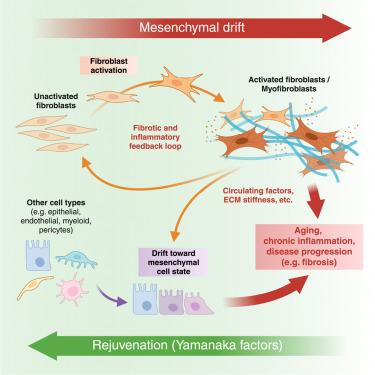Prevalent mesenchymal drift in aging and disease is reversed by partial reprogramming
IF 42.5
1区 生物学
Q1 BIOCHEMISTRY & MOLECULAR BIOLOGY
引用次数: 0
Abstract
The loss of cellular and tissue identity is a hallmark of aging and numerous diseases, but the underlying mechanisms are not well understood. Our analysis of gene expression data from over 40 human tissues and 20 diseases reveals a pervasive upregulation of mesenchymal genes across multiple cell types, along with an altered composition of stromal cell populations, denoting a “mesenchymal drift” (MD). Increased MD correlates with disease progression, reduced patient survival, and an elevated mortality risk, whereas suppression of key MD transcription factors leads to epigenetic rejuvenation. Notably, Yamanaka factor-induced partial reprogramming can markedly reduce MD before dedifferentiation and gain of pluripotency, rejuvenating the aging transcriptome at the cellular and tissue levels. These findings provide mechanistic insight into the underlying beneficial effects of partial reprogramming and offer a framework for developing interventions to reverse age-related diseases using the partial reprogramming approach.

衰老和疾病中普遍存在的间充质漂移可通过部分重编程逆转
细胞和组织特性的丧失是衰老和许多疾病的标志,但其潜在机制尚不清楚。我们分析了来自40多种人体组织和20种疾病的基因表达数据,揭示了多种细胞类型间充质基因的普遍上调,以及基质细胞群组成的改变,这表明了“间充质漂移”(MD)。MD增加与疾病进展、患者生存率降低和死亡风险升高相关,而抑制关键MD转录因子可导致表观遗传返老还童。值得注意的是,Yamanaka因子诱导的部分重编程可以在去分化和获得多能性之前显著减少MD,在细胞和组织水平上使老化的转录组恢复活力。这些发现为部分重编程潜在的有益影响提供了机制见解,并为利用部分重编程方法开发逆转年龄相关疾病的干预措施提供了框架。
本文章由计算机程序翻译,如有差异,请以英文原文为准。
求助全文
约1分钟内获得全文
求助全文
来源期刊

Cell
生物-生化与分子生物学
CiteScore
110.00
自引率
0.80%
发文量
396
审稿时长
2 months
期刊介绍:
Cells is an international, peer-reviewed, open access journal that focuses on cell biology, molecular biology, and biophysics. It is affiliated with several societies, including the Spanish Society for Biochemistry and Molecular Biology (SEBBM), Nordic Autophagy Society (NAS), Spanish Society of Hematology and Hemotherapy (SEHH), and Society for Regenerative Medicine (Russian Federation) (RPO).
The journal publishes research findings of significant importance in various areas of experimental biology, such as cell biology, molecular biology, neuroscience, immunology, virology, microbiology, cancer, human genetics, systems biology, signaling, and disease mechanisms and therapeutics. The primary criterion for considering papers is whether the results contribute to significant conceptual advances or raise thought-provoking questions and hypotheses related to interesting and important biological inquiries.
In addition to primary research articles presented in four formats, Cells also features review and opinion articles in its "leading edge" section, discussing recent research advancements and topics of interest to its wide readership.
 求助内容:
求助内容: 应助结果提醒方式:
应助结果提醒方式:


